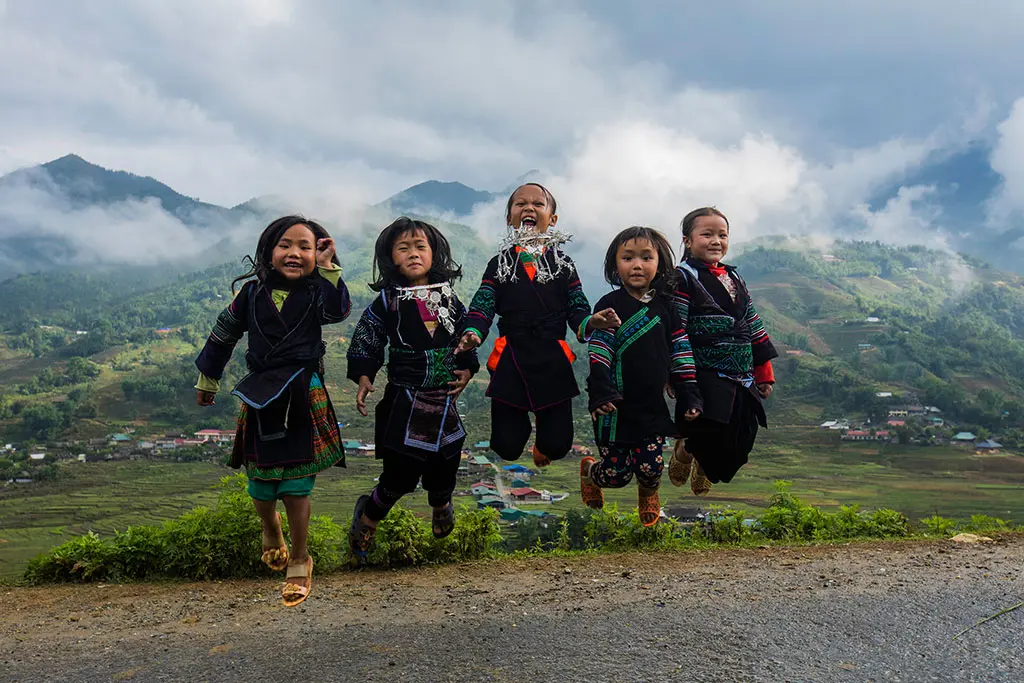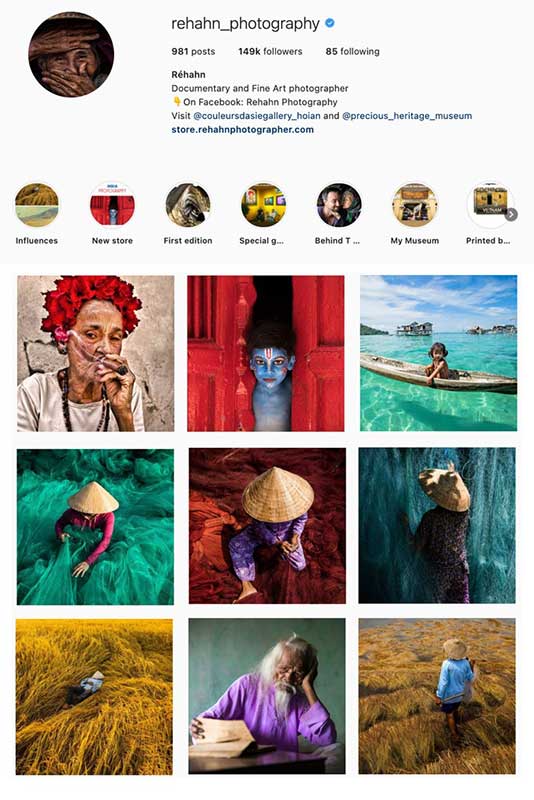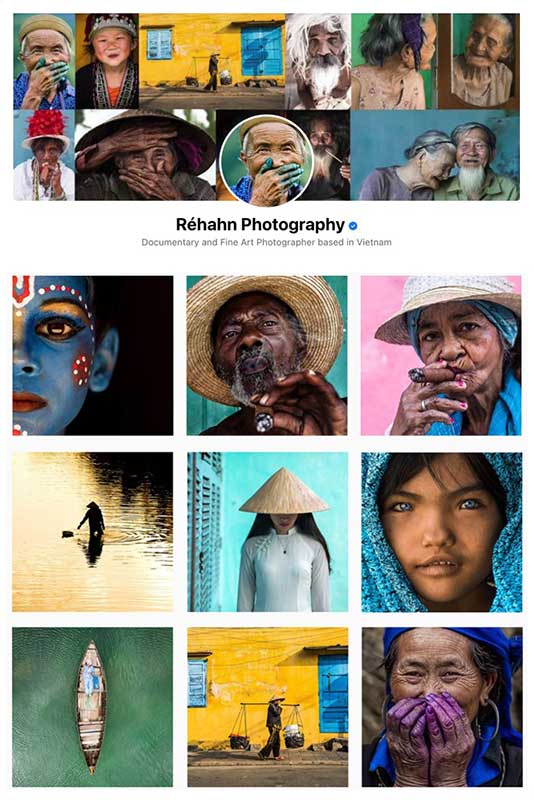The Precious Heritage Project, created by the Réhahn, presents the rich cultural traditions of the ethnic groups in Vietnam. It includes the portraits of ethnic minority groups in North, Central and Southern Vietnam to create a map of the intangible cultural heritage that remained present in the hundreds of ethnic villages throughout the country.
Réhahn opened The Precious Heritage Museum in 2017 in the UNESCO World Heritage ancient town of Hoi An, Vietnam.
In addition to the museum, Réhahn published The Precious Heritage book of Vietnam’s ethnic groups.
To learn more about Vietnam’s diverse ethnic cultures follow along below for a short introduction to all of the ethnic groups in Vietnam.
If you pass by Hoi An, don’t miss our free museum Precious Heritage
How many ethnic groups in vietnam ?
Vietnam is renowned for its rich cultural tapestry, encompassing 54 distinct ethnic groups. The Viet (Kinh) people form the majority, comprising 87% of the population. They predominantly inhabit strategic regions such as the Red River delta, the central coastal delta, the Mekong delta, and major urban centers. Meanwhile, the country’s remaining 53 ethnic minorities, totaling over 8 million individuals, are dispersed across mountainous landscapes spanning from the North to the South, covering extensive portions of Vietnam’s territory.
The map of the 54 ethnic groups of Vietnam
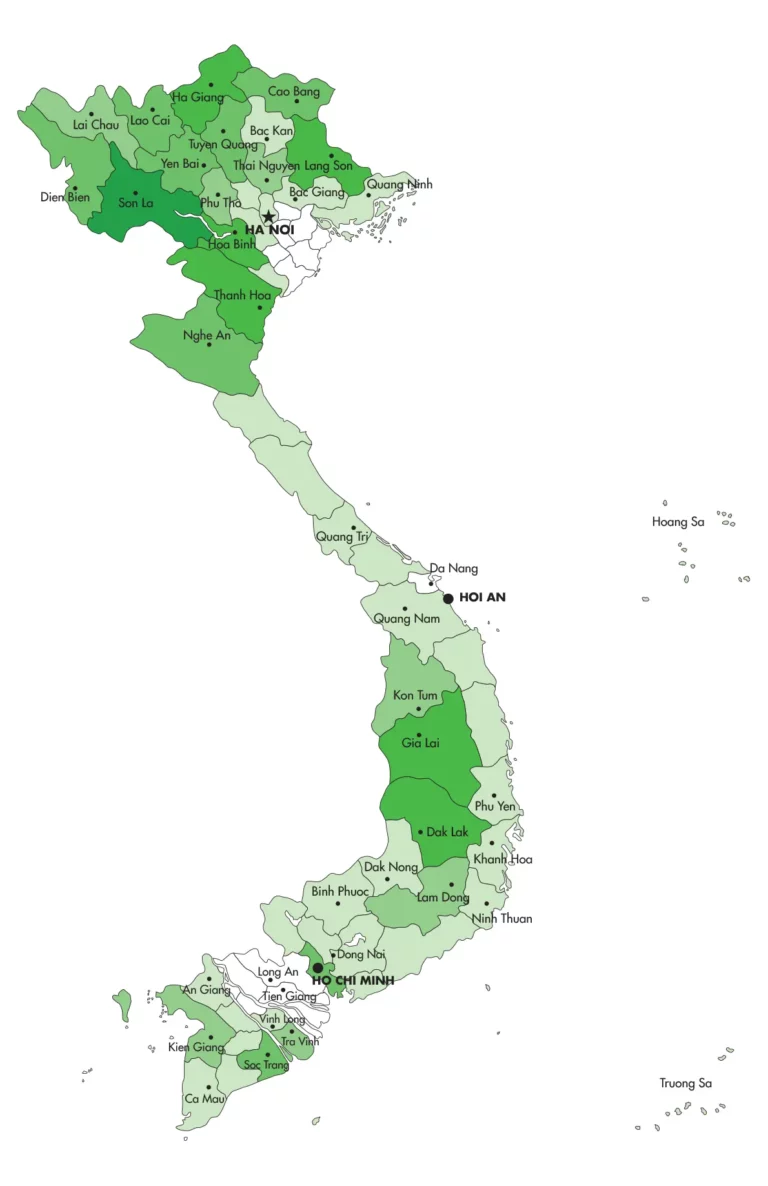
List of the 54 Ethnic Groups of Vietnam
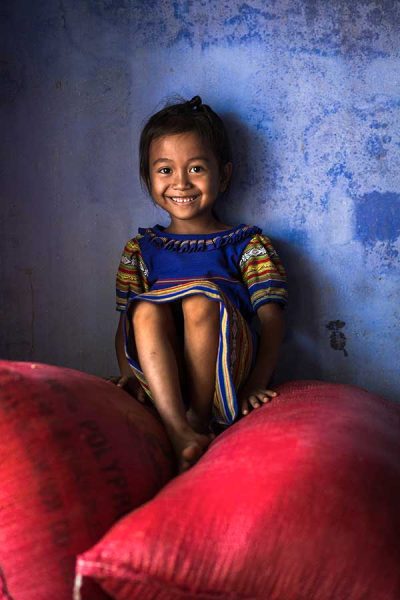
Bahnar
I met the Bahnar people for the first time in 2013, during a motorbike trip between Hoi An and Kon Tum. This ethnic minority is well known for the spectacular architecture of their communal house: often called a rong house, it is built at the center of each village. The house is characterized by its columns, which suspend it about two meters above the ground—protecting the Bahnar from tigers!—and a roof that reaches up to 20 meters in height, symbolizing the prosperity of the community.
Bahnar women are recognized for their extraordinary talent as weavers and learn the art of weaving using a traditional loom as early as 13 or 14 years of age. Now, most of their costumes are made with purchased fabric and synthetic dyes rather than natural tints.
The Bahnar people no longer wear their traditional dress every day, particularly in communities near urban areas, but making the costume is still a strong activity in central Vietnam. Most Bahnar wear their costumes during festivals to celebrate the New Year. Partnerships have recently emerged to foster the preservation and the passing down of this tradition.
Population:
286,910 people (2019)
Location:
Kon Tum, Binh Dinh and Phu Yen (Central Vietnam)
Other names:
Ba Na and also called the Ro Ngao
Language:
Austroasiatic
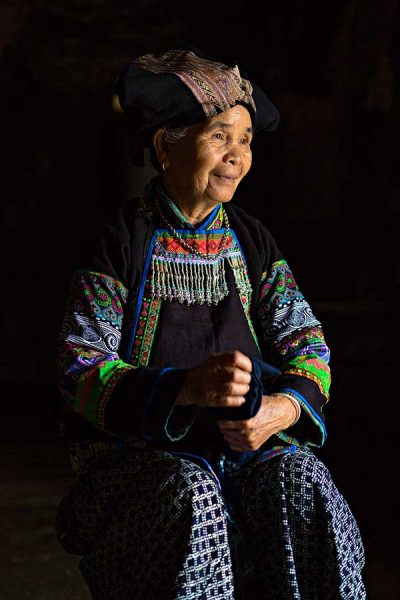
Bo Y
I met the Bo Y in 2015. The woman in this picture is 73-year-old Lu Thi Phung. When I asked her if she had one of the Bo Y traditional costumes, she beamed with pride. She said she’s the last one in her community who can still make it entirely by hand. She is able to complete four to five costumes per year, and is saddened by the fact that even though the garments are still made in the village, much of the work is no longer done by hand.
Population:
3,232 people (2019 Census)
Location:
Lao Cai, Yen Bai, Ha Giang and Tuyen Quang provinces.
Other names:
Chung Cha, Trong Gia, Tu Di, Tu Din, and Pu Na
Language:
Tai–Kadai
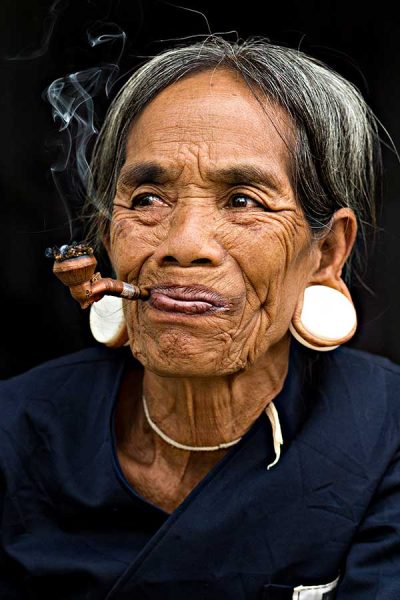
Brau
In May 2016, I had the opportunity to meet the Brau. The Brau traditionally wear heavy jewelry that strains their ears to create long hanging earlobes. They use ivory or wood depending on their level of income. According to Brau custom, youngsters who reach the age of puberty have the four front teeth of their upper jaw evenly filed. This is considered a coming of age ritual. The Brau also used to have their bodies tattooed. I was told that all the people who had their faces tattooed had passed away. No one in the village makes the costume anymore.
In 2018, I came back to give Y An, 76 years old, a book in which her portrait appears. Surprised and happy, she shared this moment with her family and gave me a beautiful traditional hat she had made. In 2020, I tried to visit with her again but sadly she had fallen ill. The village had killed a buffalo to try to heal her and no one was allowed to enter her house for two days.
Population:
525 people (2019)
Location:
Dak Me Village, Kon Tum Province
Other names:
Brao
Language:
Austroasiatic
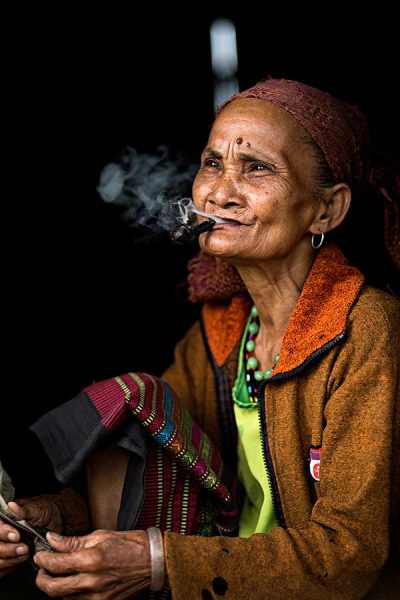
Bru-Van Kieu
Translated into Vietnamese, Bru-Van Kieu means “people living in the woods.” I was fortunate enough to visit this group from Quang Tri province in early September 2016. On arrival, I was immediately enchanted by how peaceful and happy the village felt. I asked around about their language but I couldn’t find anyone there that wrote it. Regarding their costumes, they told me that they usually only wear the skirt, which is made in Laos and then sold on the border at the main city market of Lao Bao. They say the top is too expensive to buy because no one in the village knows how to weave the traditional costume anymore.
Like many women from all over the world, the Bru-Van Kieu love jewelry, beaded bracelets and silk scarves.
Population:
94,598 people (2019)
Location:
Quang Binh, Quang Tri, and Thua Thien-Hue provinces.
Other names:
Bruu, Riang
Language:
Austroasiatic
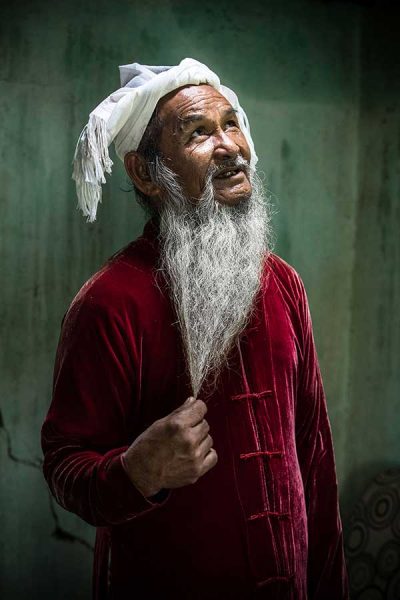
Cham
The Cham reside on the central coast and along the Mekong Delta. Their history goes back to the 2nd century when parts of south and central Vietnam were known as the Kingdom of Champa. Champa was dissolved in the 15th century but elements of their ancient civilization can still be seen in the continued strength of their culture, craftsmanship and religion. The Cham are considered to be the root of Muslimism in Vietnam; however, Hinduism is also practiced depending on the region. Cham girls and women typically wear headscarves to cover their hair in accordance with their religious beliefs.
In Chau Doc, in the Mekong Delta area, it is still possible to witness families making the silk costumes that they wear for everyday life. In An Giang, only a few families still use traditional weaving techniques. They now use industrially dyed cotton rather than silk. A typical piece of fabric is made of 3,000 threads.
Population:
178,948 people (2019)
Location:
Ninh Thuan and Binh Thuan provinces. The Cham also live in An Giang, Tay Ninh, Dong Nai provinces, and Ho Chi Minh City.
Other names:
Chiem Thanh, and Hroi
Language:
Malayo-Polynesian
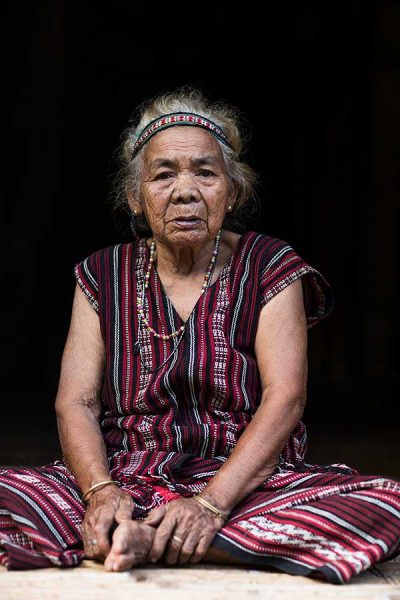
Cho Ro
I spent two days with this group in October 2016. It took numerous attempts to learn anything about the Cho Ro traditional costume. Finally, I was led to see the chief of the tribe. He was a frequent smoker and kept offering me a cigarette, which I had to politely decline because I don’t smoke them. Yet, when I brought out my cigars, he was ecstatic, shouting “Cuba” and “Castro” with glee! He was so happy when I offered him one that he invited me back the next day. To my surprise, he gifted me the last costume left in the village and his friendly wife offered to pose in it for me.
No one is making these costumes anymore, which makes this addition to the museum a valuable precious heritage indeed.
Population:
29,520 people (2019)
Location:
Dong Nai, Binh Thuan, Binh Phuoc and Binh Duong provinces.
Other names:
Do Ro, Chau Ro
Language:
Austroasiatic
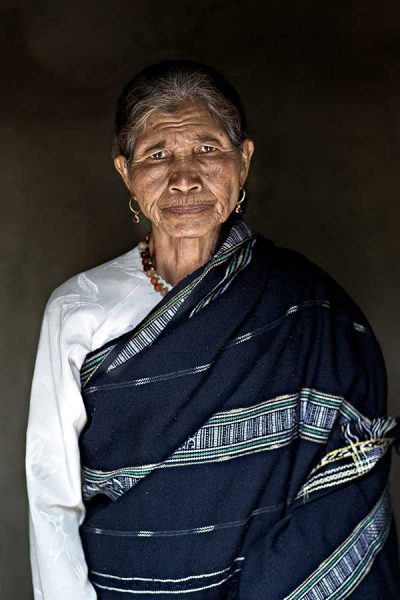
Chu Ru
The Chu Ru are said to have links to the Cham ethnic group. This is evident in the style of their costume, which resembles an Indian sari. When I visited the Chu Ru in August 2016, I met this lovely lady who kindly invited me to her house, where she proudly posed in her costume and told me about the strength of their culture. The Chu Ru, who are also known for making rice wine and wine jars, are very artistic and musical.
I was lucky to witness an 80-year-old man play his handmade musical instrument for his granddaughters. I’m proud to have a full costume, one of their musical instruments and a ring as part of the Chu Ru collection.
Population:
23,242 people (2019)
Location:
Lam Dong, Ninh Thuan and Binh Thuan
Other names:
Cho Ru and Ru
Language:
Malayo-Polynesian
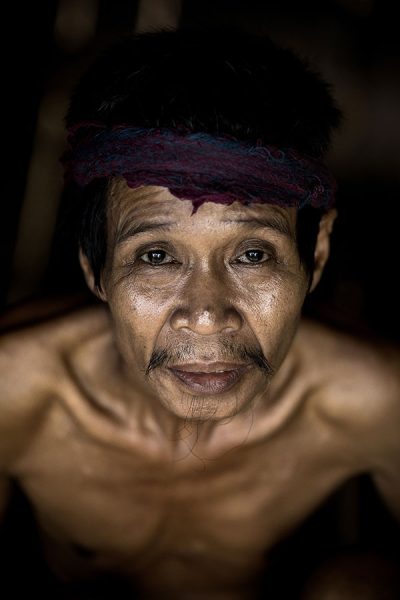
Chut
Meeting the Chut ethnic group was a memorable occasion for several reasons—the greatest of which is because this tribe, that I’d spent so many years trying to reach, also turned out to be the final ethnic minorities to complete my goal of documenting all 54 ethnic groups in Vietnam. They were found in 1959, living in a cave on the border of Laos. The group was moved to be closer to Vietnamese villages almost immediately after discovery, but they are still very difficult to access. In the past, the group was known to wear next to nothing in terms of clothing. Now they wear purchased skirts and t-shirts.
The Chut people have several dialects that were dispersed with the tribe as different subgroups settled throughout the province known for its mountainous jungle and limestone caves. Their skirts resembled that of the Bru Van Kieu, another ethnic group living in the same region; however, in contrast to the Bru, they wear purchased t-shirts from Vietnam.
Population:
7,513 people (2019)
Location:
Minh Hoa and Tuyen Hoa districts of Quang Binh Province.
Other names:
Ruc, Sach, Arem, May, Ma Lieng, Tu Vang, Pa Leng, Xe Lang, To Hung, Cha Cu, Tac Cuc, Ymo, and Xa La Vang
Language:
Vietic
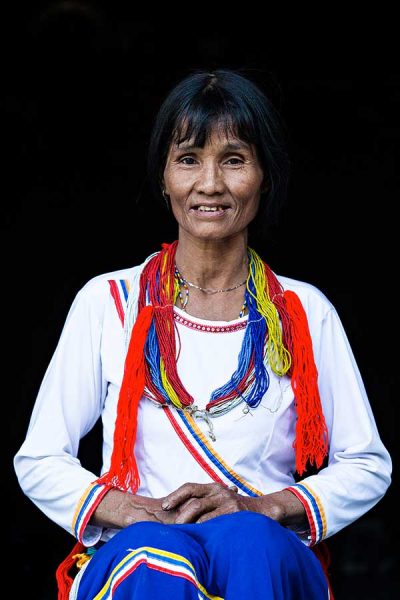
Cor
I currently have no information about where the Cor originate from but I do know that their traditional costume has been one of the hardest of the whole collection to find. It was only after visiting more than 20 villages that I finally came across this woman who owned the last original version, including the blue skirt that is no longer produced. Women traditionally wear it with necklaces made out of tiny beads following the patterns of colors on the fabric. I was honored on several occasions when representatives from the Cor visited The Precious Heritage Museum.
Population:
40,442 people (2019)
Location:
Quang Ngai and Quang Nam province
Other names:
Cor, Col, Cua, and Trau
Language:
Austroasiatic
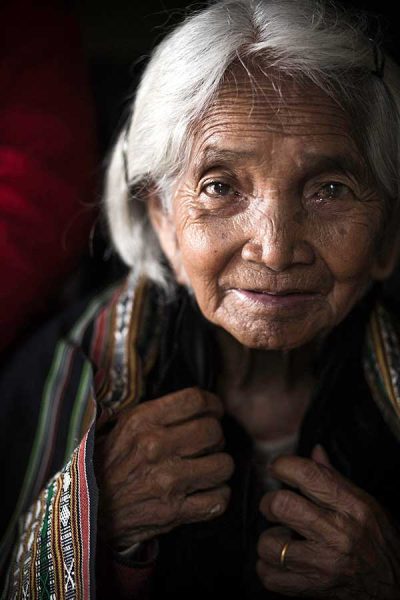
Co ho
The Co Ho, K’Ho or Koho as they are known, originate from the Lam Dong province in the Central Highlands of Vietnam. I first visited the Co Ho in August 2016 and have returned many times since. Most Co Ho people own a modern version of their traditional dress and wear it to church every Sunday. However, according to one village chief, these traditions are falling out of favor with the younger generations along with the older ways of handcrafting the costumes.
I photographed K’Long K’e, 101 years old in her traditional costume, which was different than the newer versions I’d seen. Indigo dye and hand-stitching graced her dress, which she wore draped across her shoulders like a blanket.
She passed away in 2017 at 102 years old and when I visited her village to pay my respects and to share her photograph with her family, I received an unexpectedly moving gift: her handcrafted blanket. She had passed this vintage treasure down to her daughter who chose to give it to me so that it would be preserved in the Precious Heritage Museum alongside the photograph of the family’s matriarch.
Population:
200,800 people (2019)
Location:
Lam Dong Province
Other names:
Sre, Nop, Co-don, Chil and Lach
Language:
Austroasiatic
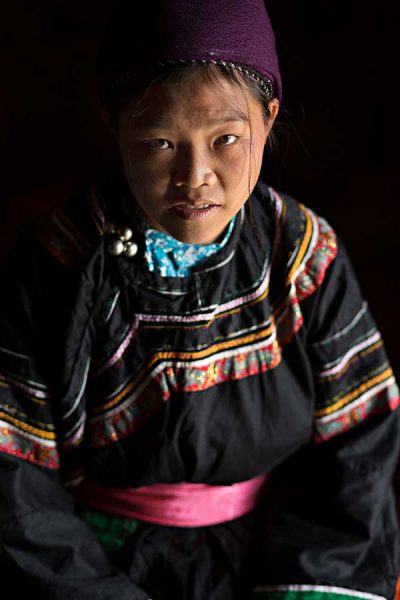
Co lao
I met the Co Lao in Dong van and found this group to be friendly and passionate about their culture. I was lucky to meet the woman in this photo because as it turns out, she’s the only one left in the village with a full costume. The Co Lao are settled in mountainous areas, and are in fact more isolated than most other ethnic minorities.
Population:
4,003 people (2019)
Location:
Ha Giang Province
Other names:
Ke Lao, Tu Du, Ho Ki, Voa De
Language:
Tai–Kadai
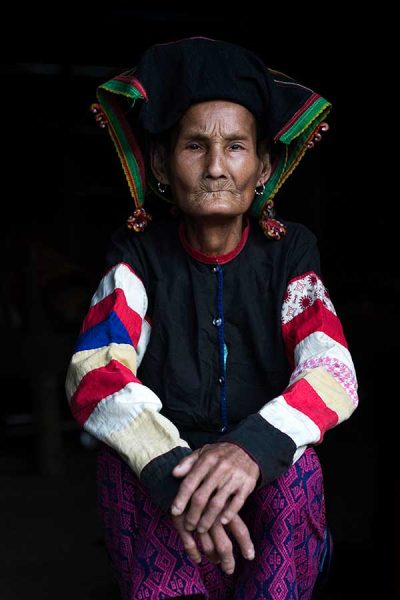
Cong
I met the Cong in July 2017 while travelling in the Lai Chau area. They had settled in Laos for centuries and more than 40,000 still live there today. A few thousand Cong migrated to Vietnam and they now represent the eighth smallest cultural group in the country. The woman portrayed here, Ly Thi Thin, 80, owned the last Cong costume. It was a great honour that she entrusted it to me to represent her culture and to raise awareness of the urgent need to protect the Cong’s heritage.
Unfortunately, I learned that in 2018 a massive fire ripped through the village and destroyed many homes and all of their traditional costumes. They currently have eight new ones but none of the originals still exist, except for the one that was thankfully preserved in the Precious Heritage Museum.
Population:
2,729 people (2019)
Location:
Muong Te District in Lai Chau province
Other names:
Xa, Xa Cong, Xam Khong, Mang Nhe, and Xa Xeng
Language:
Sino-Tibetan
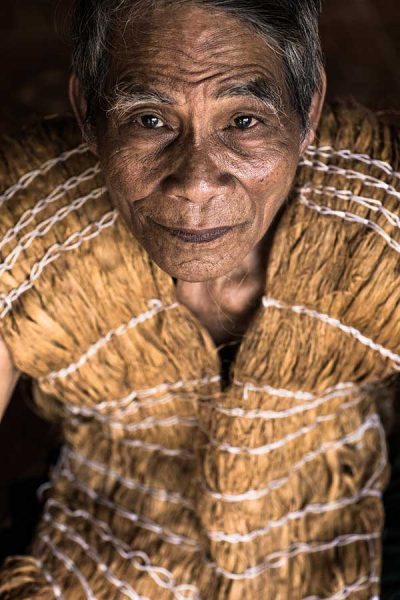
Co Tu
The Co Tu tribe is organised into two groups: the Lowland Co Tu and the Highland Co Tu. The former lives in meadows close to cities, the latter resides in isolated villages scattered throughout the forests of the Quang Nam province. For centuries, they wore tree bark costumes, which have been replaced by cotton ones that probably originated from the early 20th century. Of the groups I’ve seen in central Vietnam, the Co Tu have one of the strongest practicing cultures, with women still using traditional techniques when making their costumes.
Population:
74,173 people (2019)
Location:
Quang Nam and Thua Thien-Hue Provinces
Other names:
Gao, Ha, Phuong, and Ca Tang
Language:
Austroasiatic
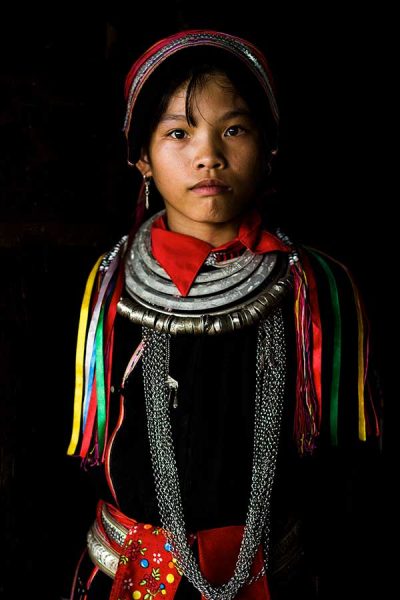
Dao
The Dao have more than 30 subgroups in Vietnam. Each group has a distinct traditional costume with different features, which help distinguish one from another. For example, the color of the headscarves and the particular way of tying them may vary from tribe to tribe. One unifying element is that the Dao women use indigo to dye their clothing and batik to create beautiful patterns on the cloth.
Population:
891,151 people (2019)
Location:
Sino-Vietnamese and Vietnamese-Lao borders and in some midland provinces and provinces along the coastline of northern Vietnam.
Other names:
Dao Quan Trang, Dao Quan Chet, Dao Tien, Dao Thanh Y, Dao Do, Man, Dong, Trai, Xa, Diu Mien, Lim Mien, Lu Giang, Lan Ten, Dai Ban, Tieu Ban, Col Ngang, Col Mua and Son Dau
Language:
Hmong–Mien
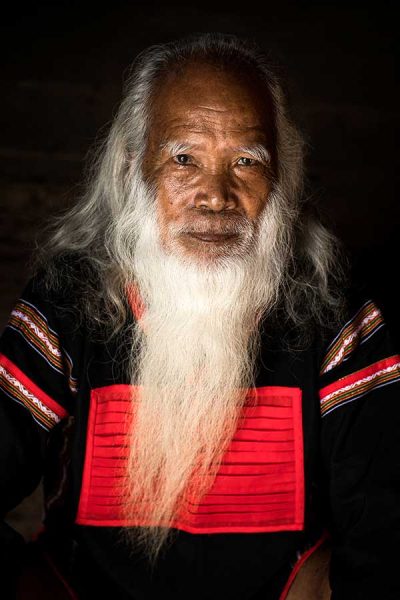
E De
The Ede are organised in a matrilineal society. Their houses have a distinctive look with some reaching up to 100 meters long! Little by little, they are being replaced with concrete structures, resulting in the disappearance of their whole ancestral social system. I’ve met the Ede on several occasions, but I never managed to find their original costume, until my trip to the Buon Ma Thuot area, in October 2017.
In most ethnic minorities, the male costume is very simple. It is usually meant to enhance the sophistication and finesse of the female dress in comparison. However, in the Ede ethnic group, the male costume is elegant and is filled with subtle details. The bright red chest piece was traditionally reserved for high social ranking, while the common costume featured short sleeves. It is still produced today and is most commonly worn during festivals.
Population:
398,671 people (2019)
Location:
Dak Lak, Gia Lai, Khanh Hoa and Phu Yen provinces
Other names:
Rade, De, Kpa Adham, Krung, Ktul, Dlie Rue, Bio, Epan, Mdhur and Bich
Language:
Malayo-Polynesian
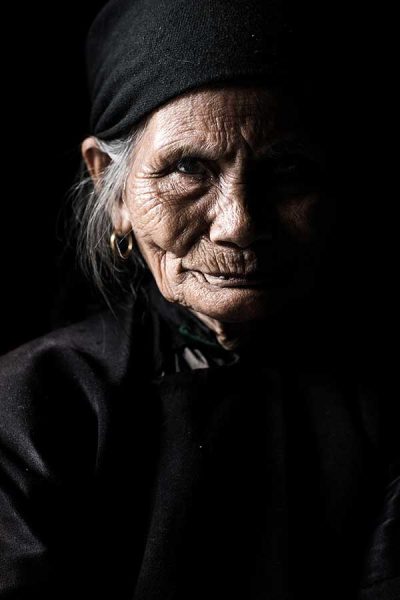
Giay
The Giay constitute one of the smallest ethnic groups in the country. They immigrated from China but settled in the northern regions of Vietnam around 200 years ago. In 2018, I decided to search for an example of the Giay traditional costume. I rode for more than two hours on my bike into the mountains to finally find the tribe. The Giay original costume was particularly subdued in its black uniformity, but this version is now practically impossible to find. In the past, the Giay made their garments from cotton; however, this new costume, which is rarely worn, is made from synthetic fabrics and purchased.
One Giay woman told me that her children asked her to burn all her old traditional clothing to make space in their house! Sin Thi Rum, 82, kindly put on an example of their original costume for this portrait.
Population:
67,858 people (2019)
Location:
Lao Cai, Ha Giang, Lai Chau Province and Cao Bang Province
Other names:
Nhang, Dang, Pau Thin, Pu Na, Cui Chu, and Xa
Language:
Tai–Kadai
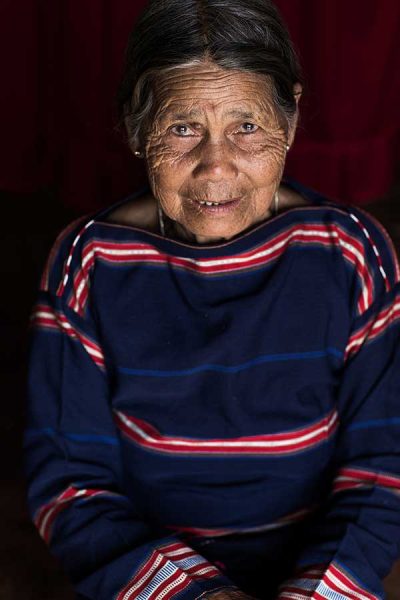
Jarai
The Jarai tribe is of Austronesian/Malay-Polynesian descent and follows a matrilineal culture, meaning their lineage is traced through the mother rather than the father. They live in several provinces around Pleiku, which is an area that is very restricted to foreigners in the highlands of central Vietnam. I did come across the woman portrayed in this photograph who was the only one in the village still able to make the Jarai traditional dress. The garment is stitched with bright colored embroidery thread that contrasts with the more somber indigo fabric.
The costume on display in the Precious Heritage Museum is an older version which is difficult to find now because the Jarai prefer the newer, brighter style. In addition, they bury their dead in their traditional clothing.
The Jarai are famous for their carved wooden masks and sculptures. The elders in the tribe expressed sadness that the younger generations don’t seem to maintain much interest in learning the Jarai heritage crafts, so they can see their traditions slowly fading.
Population:
513,930 people (2019)
Location:
Gia Lai, Kon Tum and Dak Lak Provinces
Other names:
Gia Rai, To Buan, Hobau, Hdrung, and Chor
Language:
Malayo-Polynesian
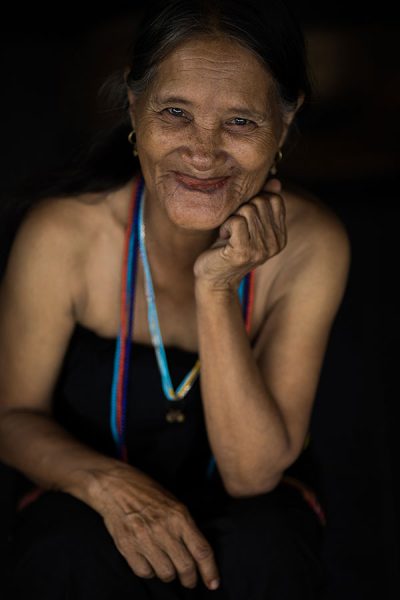
Gie Trieng
I’d already visited the Gie Trieng several times around Kon Tum in the Central Highlands of Vietnam when I discovered that there are also several Gie Trieng enclaves, including subgroups such as the Bnoong tribe, located about three hours from Hoi An.
I met the subject of this portrait, Ho Thi Gon, 70, in a Bnoong village, along with the chief of the Gie Trieng ethnic group. The Gie Trieng traditional costume consists of a skirt and a top with long necklaces made from beads. It also includes laces worn around their ankles. Amongst the women in the village, the tradition of wearing ethnic heritage costumes is still alive. They always wear their dresses to festivals and celebrations, and at the end of their lives, they are often buried in them. Each family has a costume but they don’t make them anymore. They typically buy them from Kon Tum.
Population:
63,322 people (2019)
Location:
Kon Tum, Quang Nam and Dak Lak provinces
Other names:
Dgich, Tareh, Giang Ray, Pin, Trieng, Treng Ta Lieng, Ve, La Ve, and Bnoong
Language:
Austroasiatic
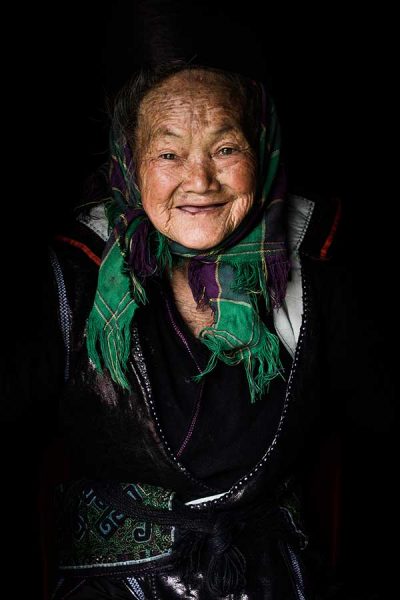
Hmong
My first trip to Sa Pa in 2012 was a memorable experience and I’ve been back ten times since then. Hmong traditions are strongly embedded in this culture with sewing skills passed down through generations. One of the specificities of this culture comes from the traditional costume that continues to evolve over time, unlike those of other ethnic groups that have remained unchanged for at least a decade. Hmong girls learn how to craft their traditional clothing starting at the age of seven.
Each one of them is made from hemp then dyed with indigo before undergoing hours of custom embroidery. This constant evolution gives hope for a more peaceful future for the Hmong, while other ethnic groups that are less flexible tend to lose their identity when they assimilate into Vietnamese culture.
Hang Thi Dinh, the woman in the picture, is 92 years old, but when I met her in May 2018, I got the impression that she talked and moved with the enthusiasm and the sense of humour of a young girl full of life!
Population:
1,393,547 people (2019)
Location:
Ha Giang, Tuyen Quang, Lao Cai, Yen Bai, Lai Chau, Son La, Cao Bang, and Nghe An provinces.
Other names:
Mong, Mong Do, White Mong, Mong Lenh (Variety Mong), Mong Si (Red Mong), Mong Du (Black Mong), and Mong Sua (Man Mong)
Language:
Hmong–Mien
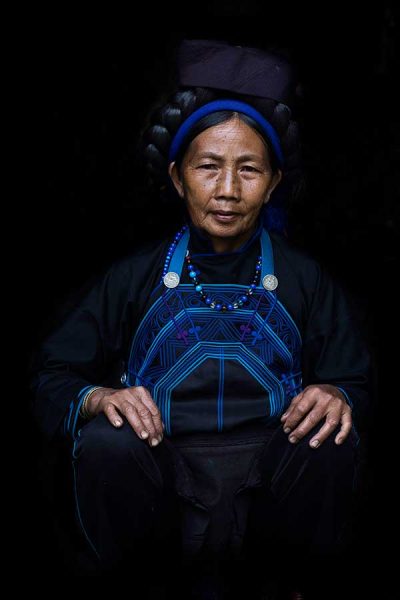
Ha Nhi
The Ha Nhi ethnic group is said to be organised into two subgroups: Black Ha Nhi and Flower Ha Nhi. I briefly met the Black Ha Nhi in 2014, and I came across them again while travelling in the Lai Chau and Lao Cai provinces in July 2017. That same trip, I also discovered a subgroup calling themselves the Pink Ha Nhi, which had never been clearly identified in my previous research. The Ha Nhi cotton indigo-dyed costume is one of the most sophisticated in the northern region. That of the Black Ha Nhi takes up to six months to make and includes large braids made out of real human hair.
Population:
25,539 people (2019)
Location:
Lai Chau and Lao Cai provinces
Other names:
U Ni and Xa U Ni
Language:
Sino-Tibetan
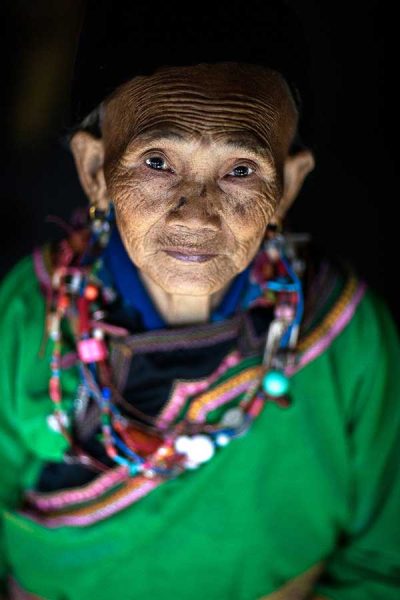
Hoa
The Xa Phang ethnic group, a subgroup of the Hoa tribe, is part of the Chinese diaspora and Chinese is still their native tongue. Their village in the Dien Bien province is set far back in a valley, which is quite difficult to access. It took me more than an hour to drive the 11 kilometers to reach the village. I was the first foreigner that the Xa Phang people had seen, so it took some time to approach them. The Xa Phang wear their traditional dress and handmade fabric shoes every day, even when they work in the fields, which is rare for tribal people.
Population:
749,466 people (2019)
Location:
Vietnam from north to south, in both urban centers and rural regions.
Other names:
Han and Xa Phang
Language:
Sino-Tibetan
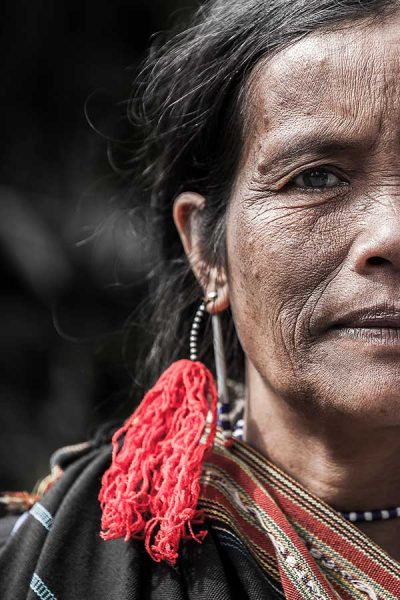
Hre
The Hre live in social units of up to 100 families. I met the Hre of the Quang Ngai province for the first time in 2013. Nobody I saw was wearing the traditional costume. It was only while I was driving back to Hoi An, that I came across this woman, on the side of the road, dressed in her tribal clothes.
I returned in 2016, specifically to explore the green surroundings of Ba To. There, I only found one village where a few local women are still making their dark indigo dress with an embroidered pattern. Although they currently work alone in their own homes, they expressed the wish to someday have a communal house that they could use as a workspace to gather as well as to pass on their knowledge.
Population:
149,460 people (2019)
Location:
Quang Ngai and Binh Dinh provinces
Other names:
Cham Re, Chom Kre, and Luy
Language:
Austroasiatic
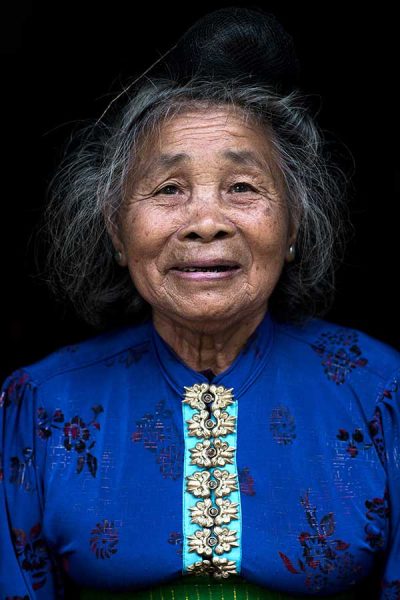
Khang
The Khang live in the Son La province on the border of Laos. Thai culture has had a strong influence on the Khang and now the similarities between the two groups are almost interchangeable.The Khang people, however, still speak their indigenous tongue along with the Thai language. Many do not speak Vietnamese.
I met Lo Thi Thang in November 2018 as she was coming back from the jungle. Even at 85, she was still out collecting firewood. She posed willingly for me and with translation assistance from the Chief of the village, I was told that neither of them had ever seen an original Khang costume. It is unclear whether the Khang people ever had a traditional way to dress that is inherently theirs or if they’d always followed the Thai way.
Population:
16,180 people (2019)
Location:
Son La, Lai Chau
Other names:
Xa Khao, Xa Xua, Xa Don, Khang Huoc, Mkhang Hoc, Mkhang Ai, Ma-hang Beng, and Ma-hang Coi
Language:
Austroasiatic
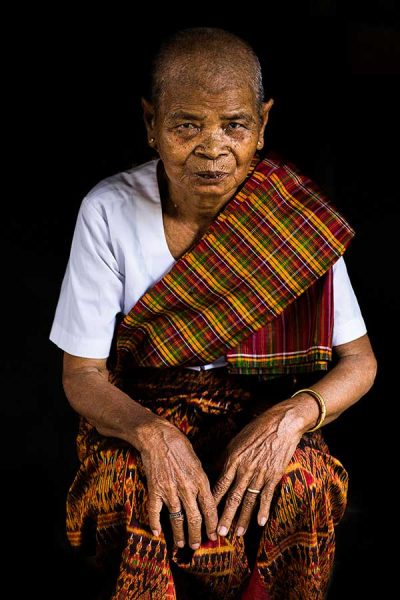
Khmer
The Khmer Krom—literally meaning “Khmer from below”—live in southern Vietnam where they constitute the second largest ethnic group of the Mekong Delta, after the Kinh. Generally speaking, it is very rare to come across the Khmer wearing their traditional costumes in their everyday lives. Only women over 50 years of age still wear it regularly to go to the temple, and shave their hair as a sign of respect for the Buddha.
I only visited one village where two or three families are still able to make it. Yet, this silk costume is a true wonder, with patterns replicating Buddhist images of the temple. In the past, the Khmer produced their own silk, but they now buy it from the Kinh.
They still dye yarns with colored powders, though the powders come from Thailand rather than being made from plants harvested in the forest.
I met Neang Phong, 83, a few years ago while she was sewing a traditional costume on her doorstep. When I returned, she recognized me, and I was able to capture this image of her wearing it.
Population:
1,319,552 people (2019)
Location:
Soc Trang, Tra Vinh, Can Tho, Kien Giang, and An Giang provinces
Other names:
Cur, Cul, Cu Tho, The Viet is of Mien origin and Khmer Krom
Language:
Austroasiatic
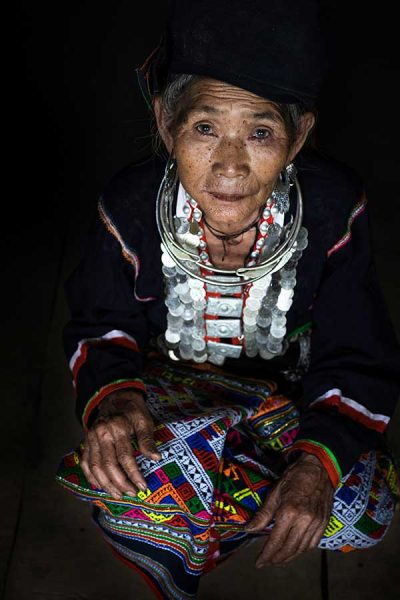
Kho Mu
In my early expeditions, I only found Kho Mu villages surrounded by Thai villages, whose culture had strongly influenced the tribe’s traditions. However, during a new expedition in 2017, I discovered a more isolated village whose remote location had perhaps helped to preserve the Kho Mu culture. In this location, there were still resemblances with Thai architecture. However, the village seemed to have maintained its distinct Kho Mu identity. As for the costume, the skirt is similar to that of the Thai, but the jacket that accompanies it is unique. On the front, the piece is decorated with silver coins. Like armor, the jacket is used to serve as protection and is considered a lucky charm.
Population:
90,612 people (2019)
Location:
Nghe An, Lai Chau, Son La, Thanh Hoa, and Yen Bai provinces
Other names:
Xa Cau, Mun Xen, Pu Thenh, Tenh, and Tay Hay
Language:
Austroasiatic
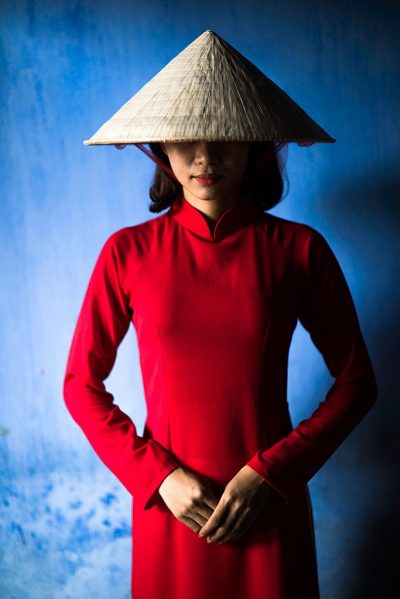
Kinh
The Kinh, more commonly known as the Viet, are the largest ethnic group in Vietnam making up 85.7% of the total national population. The Kinh reside in all provinces in Vietnam and speak Vietnamese, though the dialect can change dramatically based on the region. I’ve lived with the Kinh since I moved to Hoi An with my family in 2011. I chose the ao dai to represent them because its iconic beauty is so emblematic of Vietnam. Some are handmade, many are not. They can be simple or ornately embroidered, cotton or silk, worn by men, women and children but the one unifying characteristic is the shape of the slim tunic worn over loose pants.
Population:
82,085,826 people (2019)
Location:
All provinces of Vietnam
Other names:
Viet
Language:
Vietic
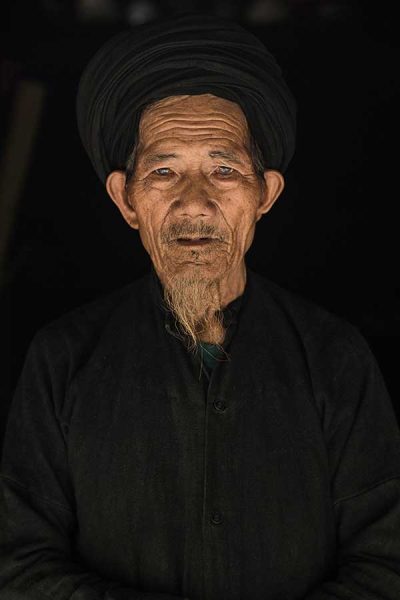
La Chi
The La Chi are very resourceful artisans. The women are skilled at weaving, dyeing and embroidery. Men are excellent builders and make household items from rattan and bamboo. La Chi houses are usually built on stilts and are surrounded by thick clay walls. Their traditional clothing is simple and elegant. Few women wore these garments in the village when I visited.
However, I was surprised to meet a man, 78-year-old Lung Leo Pho, who was fully dressed in his costume. In 2019, I met the La Chi village in Hoang Su Phi, and saw groups of women sitting on the floor and preparing the cotton, which is one of the rare ethnic groups to still grow cotton for their traditional clothing.
Population:
15,126 people (2019)
Location:
Ha Giang and Lao Cai Provinces
Other names:
Black Tho, Mán, Xá, Cu Te and La Qua
Language:
Tai–Kadai
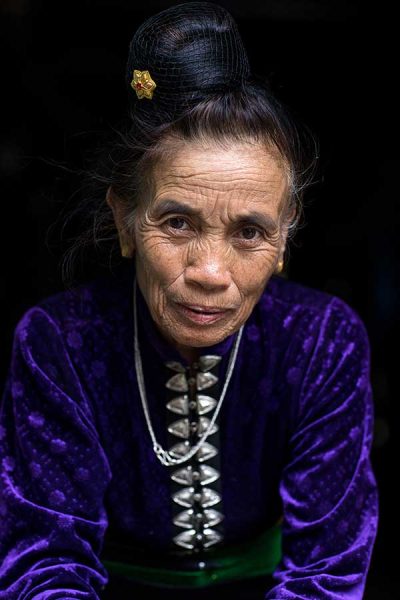
La Ha
The La Ha tribe is of Austro-Asian descent. Their village is set deep in the mountains of the Son La province. The area is a restricted zone and I was stopped by the local police after only a few minutes in the territory. Luckily, I was carrying the permit that had been issued to me by the Government of Hanoi. Though the La Ha tribe has been strongly influenced by the Thai people, they still speak their native La Ha language in the mountains. However, in the lowlands, I also met La Ha people who couldn’t speak their native tongue and they were sad to have lost this part of their heritage.
Quang Thi La was already dressed in her traditional costume when I arrived. Her costume, like the others in the village, had been purchased from the Thai people. Her wit and good humour made her a memorable subject to photograph.
Population:
10,157 people (2019)
Location:
Son La and Lao Cai provinces
Other names:
Xa Cha, Xá Bung, Xá Khao, Xá Táu Nha, Xá Pojoong, Xá Uong, Bu Hà, Pua, Phlao, Xa Khan, and Khla
Language:
Tai–Kadai
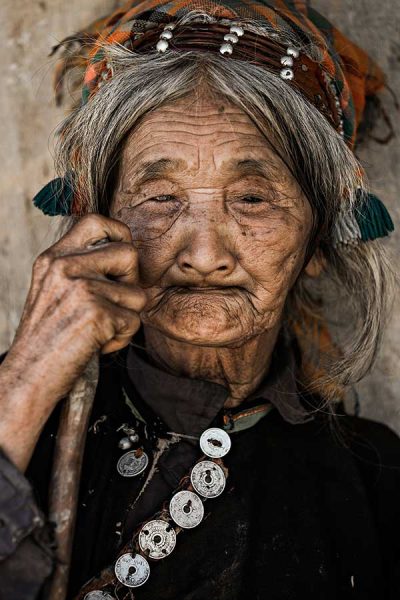
La Hu
La Hu is said to mean “as powerful as a tiger” and, indeed, the tribe was known for being especially skilled at hunting tigers in the past. The La Hu have no written language and most of them do not speak Vietnamese, which led me to call for the help of a local interpreter.
I had the chance to capture this portrait of Ly Ca Su, 91 years old at the time but had to shorten my stay among the La Hu after a motorcycle accident. I was finally able to go back to visit Ly Ca Su again three years later. She gave me one of her costumes for the museum and I was able to finally take my time to learn more about the culture of this fascinating group.
Population:
12,113 people (2019)
Location:
Lai Chau Province
Other names:
Xa La Vang, Co Rung, Khu Sung, and Kha Quy
Language:
Sino-Tibetan
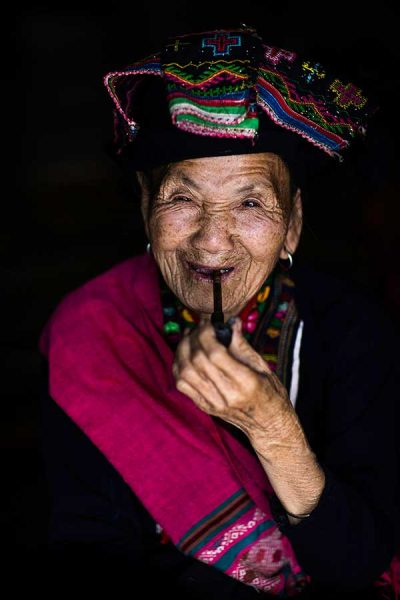
Lao
The Lao tribe from the Dien Bien province originated in Laos. Their indigenous language sounds similar to Laotian with subtle differences. In the past, the Lao grew cotton and indigo to weave and dye the fabric used to make their clothing. Today, they buy the fabric, but elders in the village still weave and embroider their decorative brocade by hand. Younger generations prefer to buy costumes from Laos, which they wear for celebrations, rather than following the traditional methods of their mothers and grandmothers.
Lo Thi Banh, 94, was my favorite subject, laughing at the novelty of being photographed as she smoked. Like other women of her generation, she wore small, silver earrings to stretch her ears. This village seems to be the last one where costumes are still made in the Lao fashion. Lao in other regions typically wear costumes made by the Lu tribe.
Population:
17,532 people (2019)
Location:
Dien Bien, Lai Chau and Son La Provinces
Other names:
Lao Boc and Lao Noi
Language:
Tai–Kadai
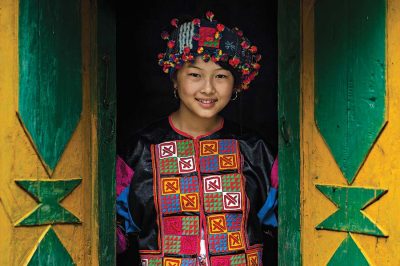
Lo Lo
The Lo Lo are divided into three subgroups: the Flower, the Red and the Black Lo Lo. The latter two groups get their names from the main colors used in their clothing, whereas the former is thus named because of the hundreds of tiny fabric triangles individually sewn onto their tunics to create a colorful mosaic. In 2013, I met the Black and Flower Lo Lo. The Lo Lo Hoa still make and wear their traditional costumes. Considered as one of the finest in Vietnam, it is also the most expensive, worth around $1,200 USD. The reason? The costume is covered with hundreds of appliquéd triangles, and it takes two hours to stitch five of them!
Population:
4,827 people (2019)
Location:
Ha Giang, Cao Bang and Lao Cai Provinces
Other names:
Mun Di, Lo Lo Hoa, and Black Lo Lo
Language:
Sino-Tibetan
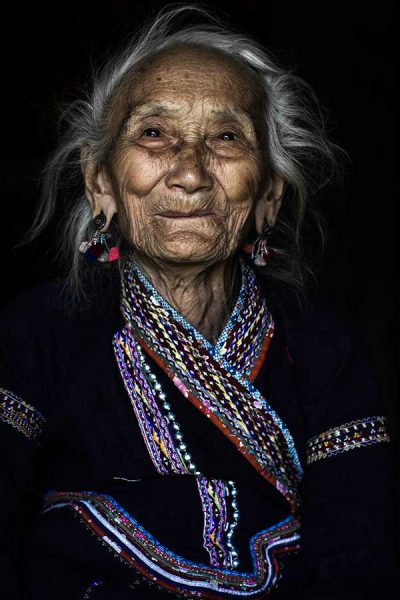
Lu
I met the Lu in July 2017 in the Lai Chau area, where they live in one of the best-preserved villages I’ve ever visited. There, the atmosphere is peaceful and joyful, the traditional stilt houses have been kept intact and each household still makes their traditional costume, including the younger women. The Lu’s passion for their own culture is obvious and they’ve developed ecotourism, which I believe, participates positively to its conservation. The cotton costume, dyed in indigo and embellished with bright embroidery, is still worn regularly. The skirt is worn every day and the jacket, which is tight around the hips and flared (both feminine and sophisticated), is only worn occasionally.
The distinctive Lu headdress is actually a scarf, always knotted on the left side of the face.
These days, it’s reserved only for special events due to the complexity and time required to put it on. As for jewelry, the belief is that the earrings keep them in good health and ensure a long life, so women wear them from an early age and throughout their life.
Population:
6,757 people (2019)
Location:
Lai Chau Province
Other names:
Nhuon and Duon
Language:
Tai–Kadai
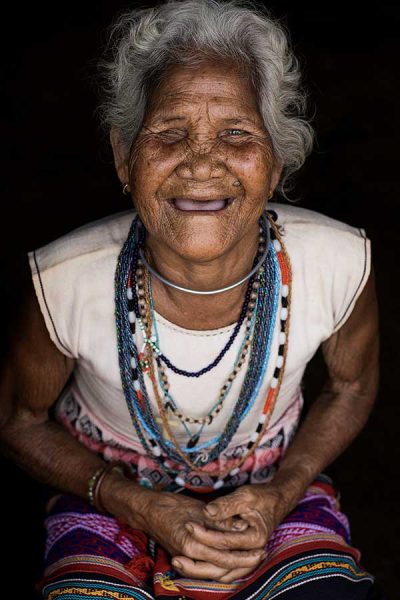
Ma
When previously isolated ethnic villages get absorbed by urban sprawl, the westernised way of living takes over the ancestral local traditions. I thought this was the case when I met the Ma for the first time in 2014 and couldn’t find any village with a traditional Ma garment.
But in May 2017, I came across a local woman in her forties who was eager to help me discover her culture and more genuine villages. She took me to a remote village where I met K’Mang, 103 years old, a beaming woman with limitless energy and a wicked sense of humour. The white Ma costume has been replaced with a black version with bright details, but there are almost none left. The parents, in awareness of the decline of their traditions, teach their culture and language to their children.
Population:
50,322 people (2019)
Location:
Lam Dong Province
Other names:
Chau Ma, Ma Xop, Ma To, Ma Krung, and Ma Ngan
Language:
Austroasiatic
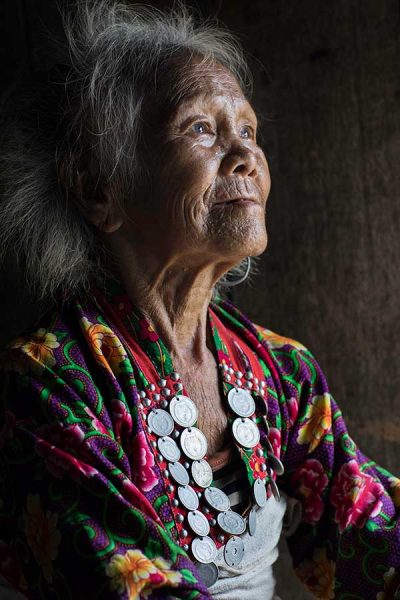
Mang
Ethnologists believe the Mang are indigenous to Vietnam’s northwesternmost corner. For a long time, they lived a nomadic lifestyle – hence their nickname “The Wanderers”. They eventually settled in 1945 at the Chinese border, establishing some of the most disadvantaged villages I’ve ever come across. They don’t have a written language to write down their history and tribal stories. In addition, their traditional costumes are no longer being made.
I was able to make contact with them in July 2017. The woman in the portrait was almost blind but moved me with her warmth and kindness. She owned two traditional costumes composed of a vest decorated with silver coins and a thick belt wrapped around the chest.
Population:
4,650 people (2019)
Location:
Lai Chau and Dien Bien Provinces
Other names:
Mang U and Xa La Vang
Language:
Austroasiatic
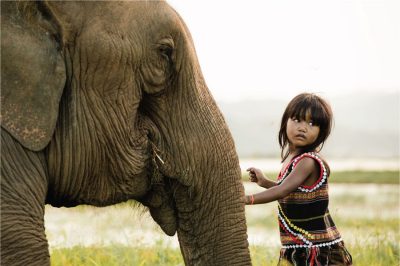
Mnong
The Hre live in social units of up to 100 families. I met the Hre of the Quang Ngai province for the first time in 2013. Nobody I saw was wearing the traditional costume. It was only while I was driving back to Hoi An, that I came across this woman, on the side of the road, dressed in her tribal clothes.
I returned in 2016, specifically to explore the green surroundings of Ba To. There, I only found one village where a few local women are still making their dark indigo dress with an embroidered pattern. Although they currently work alone in their own homes, they expressed the wish to someday have a communal house that they could use as a workspace to gather as well as to pass on their knowledge.
Population:
127,334 people (2019)
Location:
Dak Lak, Dak Nong, Lam Dong and Binh Phuoc provinces
Other names:
Mol, Mual, Mul, and Mon
Language:
Austroasiatic
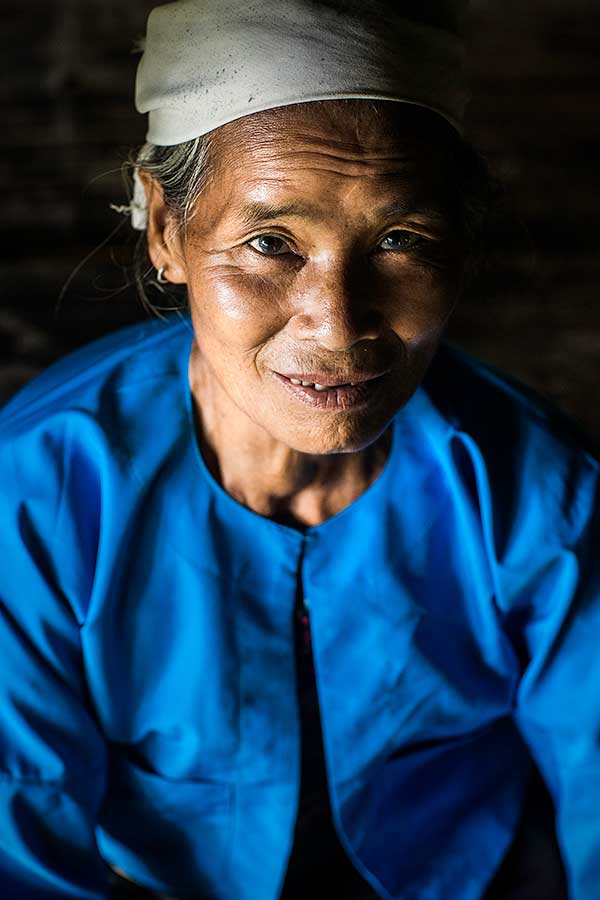
Muong
With around 1.4 million members, the Muong represent the third largest cultural group in Vietnam. They are very close to the Vietnamese, both in origin and linguistics, sharing more than 75% of their vocabulary. During the country’s Chinese occupation, the Muong were largely uninfluenced by Chinese culture because of their remote location in the mountainous provinces of Hoa Binh and Thanh Hoa.
Due to this, they are now often considered to be the only descendants of the first Viet. The simplicity of the black skirt and short jacket on their traditional dress contrasts with the fine detail of the belt (yêm)—a piece of fabric worn across the chest—and the edge of the skirt made of cotton brocatelle. These beautiful accessories reveal the weaving capabilities of the Muong women, a skill that once was considered an essential quality for any “good wife.”
Women can pick from more than 40 symbols for the decoration of these pieces. For instance, the dragon, which was initially reserved for the nobles in the old feudal system.
Population:
1,452,095 people (2019)
Location:
Hoa Binh and Thanh Hoa Provinces
Other names:
Moi, Mual, Moi, Moi Bi, Au Ta, and Ao Ta
Language:
Vietic
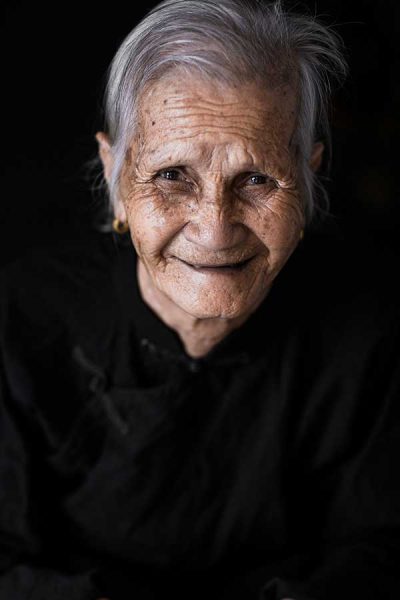
Ngai
The Ngai live mainly in Thai Nguyen province in the northeastern area of Vietnam. Their culture seems to be changing rapidly. The youth no longer speak the Chinese-based language. Some villagers mentioned wanting to start classes to teach the language to their children but they lacked the infrastructure. The last of their traditional homes was destroyed one week before I arrived, to be replaced by modern houses. There are only 1,600 Ngai left in Vietnam, so it is doubtful that their heritage is being preserved elsewhere in the country.
A woman named Madam Hau is the last person in the village who can still make the costume. Ngai costumes are dyed with indigo or other plants that tint the purchased fabric a dark green or even black. The clothing is buried with the owner when he passes away. 87-year-old Tham Thi Keo wore the only costume left in her village for her portrait.
Population:
1,649 people (2019)
Location:
Quang Ninh, Bac Ninh, Cao Bang and Thai Nguyen provinces
Other names:
Ngai Hac Ca, Lau Man, He, Sin, Dan, and Le
Language:
Sino-Tibetan
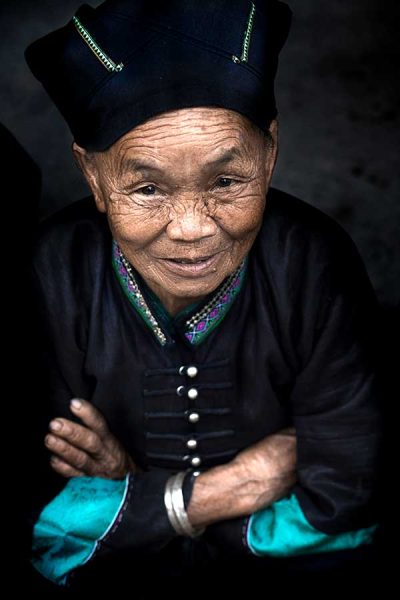
Nung
In 2015, I met Lu Da Sin, 70, at the incredibly vibrant Hoang Su Phi Market. It is said that Nung women wear 12 different colors to match each month of the year. Their clothing is made up of a subtle jacket accessorized with silver buttons, jewelry and intricate embroidery. The silver is worn for the benefit of their health: they believe that it is a thermometer that can measure epidemics. The Nung still wear their traditional clothing regularly.
I returned in 2019, and tried to find Lu Da Sin again. She was very happy to receive a copy of The Precious Heritage Museum book with her portrait in it. She could only speak a little bit of Vietnamese but despite our struggle to communicate, she asked me to stay for lunch and we had a memorable afternoon together.
Population:
1,083,298 people (2019)
Location:
Lang Son, Cao Bang, Bac Thai, Bac Giang, Bac Ninh, and Tuyen Quang provinces
Other names:
Xuong, Giang, Nung An, Nung Coi, Phan Sinh, Nung Chao, Nung Inh, Qui Rin, Nung Din, and Khen Lai
Language:
Tai–Kadai
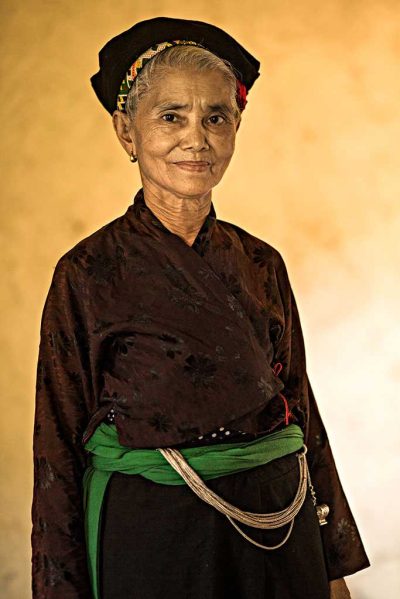
O Du
In July 2016, I was privileged to meet the smallest ethnic group in Vietnam. I learned that only ten people left in the village could speak the original dialect called Phrom, all of whom are over the age of 70. Sadly, no one is able to read or write it, making it difficult to learn. Some of the elders attempted to teach the language but they stopped after a few weeks because of a lack of participation. I was given a costume, worn in this portrait by Vi Thi Dung, 78, who was the last person making the skirt in the village.
Population:
428 people (2019)
Location:
Nghe An Province
Other names:
Tay Hat
Language:
Austroasiatic
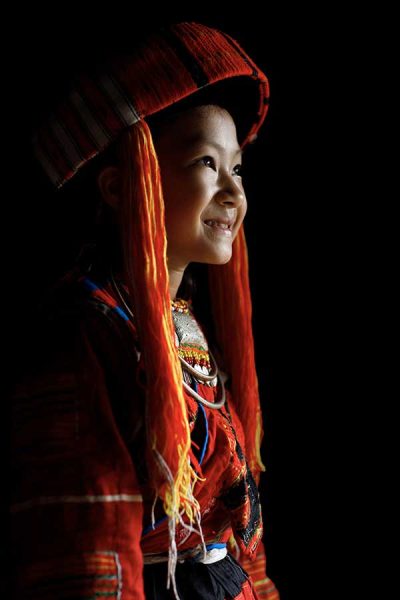
Pa then
After a challenging trek I finally found the Pa Then in 2015. I was amazed by the beauty of the one elaborate costume left in the village. In February 2019, I decided to visit the Pa Then in the Tuyen Quang province, and was intrigued to learn about an ethnic boarding school in the district where students wear their traditional costumes to school every Monday as a way to hold on to their heritage.
Huong, the eight-year-old girl in this photograph, was delighted to get dressed in her outfit. The costume is extremely complicated (just the hat can take 30 minutes to roll!) There are only two people left in the village who can still weave the fabric to make the flower-inspired costume.
Population:
8,248 people (2019)
Location:
Ha Giang and Tuyen Quang provinces
Other names:
Pa Hung and Tong
Language:
Hmong–Mien
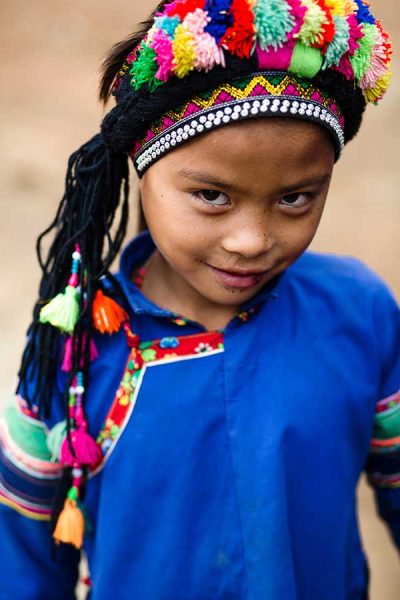
Phu La
A Phu La village is usually made up of around 10 to 15 households who all live together as a community. The chief and the village elders play a very significant role in managing the affairs of the tribe. In 2015, when I visited this group in a northern village near Bac Ha, I found it to be a challenging undertaking in more ways than one. I tried to find out more about their traditional costumes but soon discovered that sadly, they are no longer made there.
While meandering around the village, I encountered a curious and friendly mother and daughter. The smile of the little girl in this photo is so cheeky and, yet, so wise. I love the intense blue of her intricately embroidered hat, which can be seen in the glass cabinet of artefacts in the museum.
Population:
12,471 people (2019)
Location:
Lai Chau, Son La, Lao Cai, and Ha Giang provinces
Other names:
Xa Pho, Bo Kho Pa, Mu Di Pa, Pho, Va Xo, and La Dun Dang
Language:
Sino-Tibetan
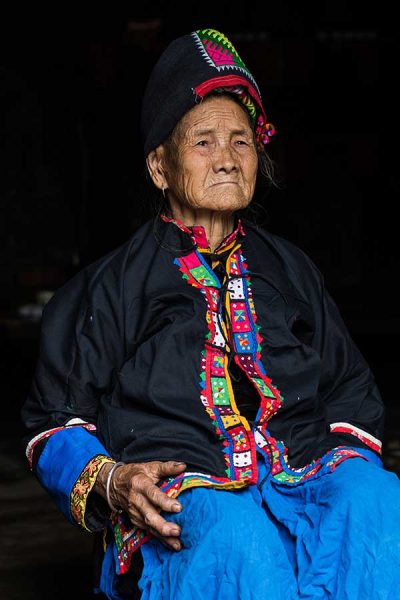
Pu Peo
On my first expedition in 2015, it took me a whole day to find the Pu Peo village, which is situated near the Chinese border. When I finally arrived, the authoarities asked me to leave after only 25 minutes! I still managed to capture this image of Giang Chan Lan, a striking 83-year-old woman and the oldest person in the village. She was wearing a pair of handcrafted shoes, which she’d had for over 65 years! She explained that she only wore them on special occasions. The main colors of the Pu Peo’s costumes are red and blue. It is believed that red represents the woman’s respect for man and blue honors the woman.
In 2019, I returned to the village and was met with no resistance. I had time to learn more about the culture, and was told that, unfortunately, nobody had a full costume anymore. Many of the costumes were purchased by people outside of the village. Madam Lan, now 88, was happy to receive a copy of the Precious Heritage Museum book.
Population:
903 people (2019)
Location:
Ha Giang Province
Other names:
Ka Beo, Penti, and Lo Lo
Language:
Tai–Kadai
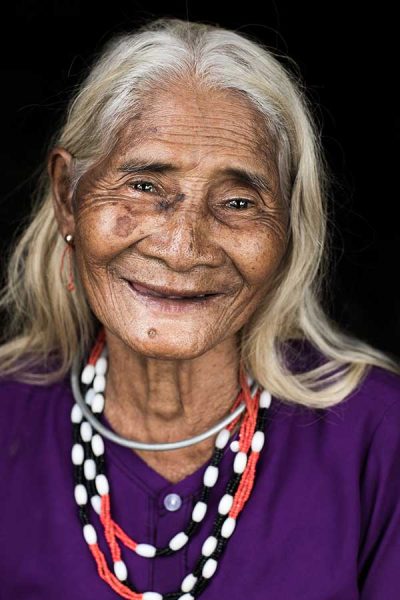
Raglai
The Raglai, said to be distant cousins of the Cham, have always been a sedentary group. I went to search for them in October 2017. Only a few hours away from the glittering beach resorts of Nha Trang, their villages, nestled in the mountains and organised around stilt wooden houses with thatched roofs, stand out in stark contrast. However, concrete is little by little replacing their traditional natural materials.
My encounter with this tribe was one of my most poignant experiences over the course of my search for the 54 ethnic groups. Their story reveals the challenging relationship that can develop between ethnic groups and national unity. After the war, many Raglai decided to burn their costumes, denying their own uniqueness to blend in with the Kinh. As a consequence, the costume— traditionally made of brocatelle—almost disappeared, and was replaced with a basic single colored sarong or Kinh clothing.
The chief of the village shared with me his concerns regarding the future recognition of his culture, a feeling shared by Pi Nang Thi Xea, 85, who entrusted me with her costume.
Population:
146,613 people (2019)
Location:
Khanh Hoa and Ninh Thuan provinces
Other names:
Ra Glay, Krai, Orang Glai, No-Ana, and La Vang
Language:
Malayo-Polynesian
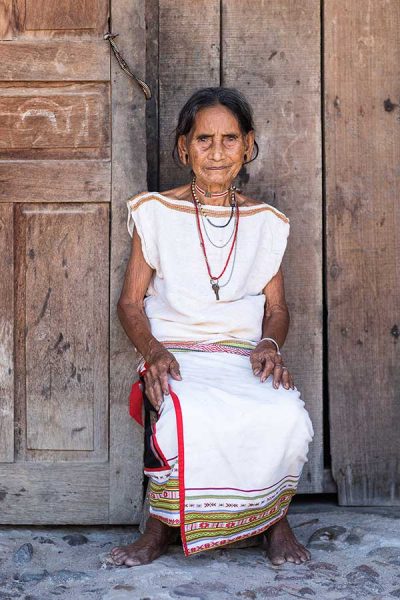
Ro Mam
Meeting the Ro Mam was definitely one of the most intense, yet memorable, experiences I’ve had over the course of my research. I’d been waiting three years for authorization to visit the area that the tribe resides in. Finally, in November 2016, thanks to the efforts of VTV1, a national TV channel, I was able to visit the village located in a restricted area that is 20km from the Cambodian border. Accompanied by the TV crew, it took us three and a half hours in a 4WD to cover the 51 km that separates Mo Rai from the closest town! We can presume that no outsiders had been allowed there since the war.
Of the 12 remaining traditional costumes, I was honoured to receive one, along with a pipe and a basket, to showcase their culture. I was invited to lunch with the chief of the village where he presented me with the costume. The woman pictured, posed in it as a token of remembrance.
The remaining 11 white costumes are kept as treasures by the Ro Mam in awareness that no one makes them anymore.
Population:
639 people (2019)
Location:
Kon Tum Province
Other names:
Ro Mam Ale
Language:
Austroasiatic
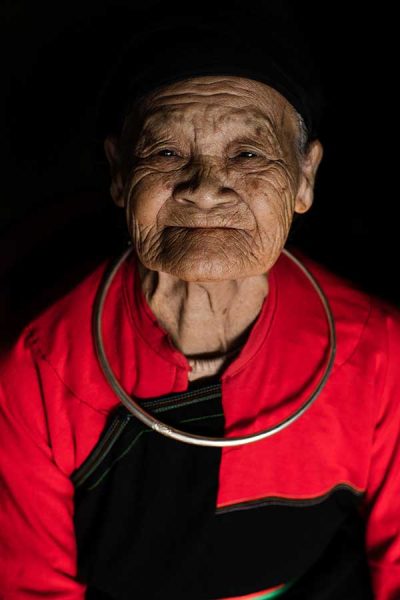
San Chay
In November 2017, I found the Cao Lan (San Chay) while on an expedition in the northeastern mountainous province of Yen Bai. Ly Tien Sinh, 85, had been chief for more than 20 years and can read, speak and write in Nôm, the sino-vietnamese calligraphy, which prevailed until the introduction of the Latin alphabet. Their poetry and folk songs—chanted during the competition of Sinh Ca—are the pride of the Cao Lan and have been recognized as part of the valuable Intangible Cultural Heritage of the nation.
The 85-year-old woman in the portrait is his wife. She is wearing the Cao Lan post-war costume. The original indigo color has been replaced with red and black. Today, it is only worn for special occasions and the turban has completely disappeared.
Population:
201,398 people (2019)
Location:
Tuyen Quang, Thai Nguyen, and Bac Giang provinces
Other names:
Cao Lan, San Chi, Man Cao Lan, and Hon Ban
Language:
Tai–Kadai
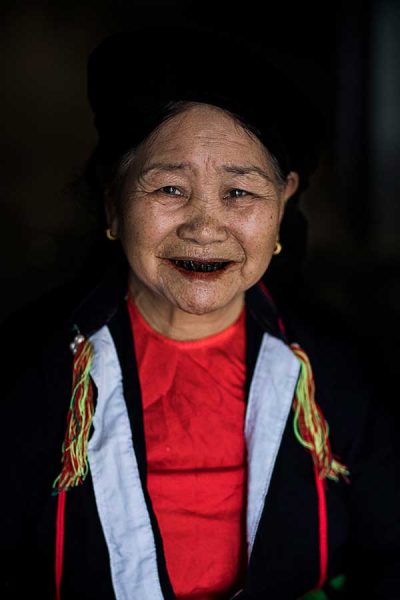
San Diu
The San Diu live in Tuyen Quang and Thai Nguyen provinces. In the past, they used to grow cotton and indigo flowers to weave and dye their traditional costumes. Now, they mainly buy the fabric in the market, then sew it to match the ancient San Diu style. The women rarely wear the costumes now, only those who sing at ethnic festivals might have new ones. However, many of the villagers still seemed proud to own these heritage garments and were happy to show them off. One of the families even gave me a costume to display in the museum.
I met Mac Thi Sinh, the 75-year-old woman in this portrait, at a wedding. She was delighted to show me the detailed work on her clothing, and to pose for me. She even sang the traditional San Diu music called “Soong Co.”
Population:
183,004 people (2019)
Location:
Quang Ninh, Hai Duong, Bac Giang, Bac Ninh, Vinh Phu, Thai Nguyen, and Tuyen Quang provinces
Other names:
San Deo, Trai, Trai Dat, and Man Quan Coc
Language:
Sino-Tibetan
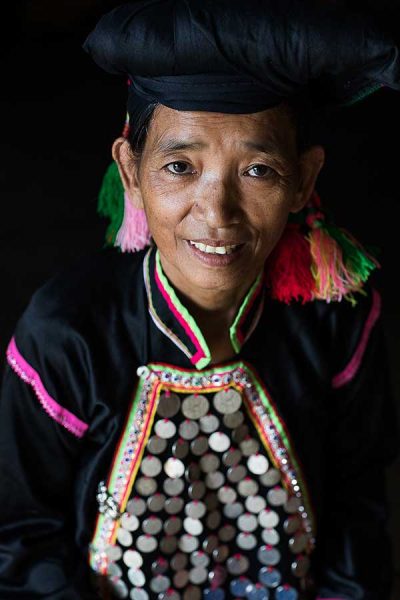
Si La
With only 909 members left, the Si La are Vietnam’s fifth smallest ethnic group. There is very little information about their group but Hu Gu Si, 83, sang their story to me. The lyrics reveal that they originated from the Philippines before migrating to Laos where the lack of food and the harsh living conditions forced them to cross the border. They now live self-sufficiently in the hostile and remote valleys of Lai Chau.
As for the costume, it isn’t really made anymore, it is mostly kept for special occasions or official representations. Its originality comes from the alignment of the silver coins covering the chest, believed to bring good luck and ensure good health. It is worn with a black scarf rolled around collected hair to which the Si La attribute a high spiritual value. At a woman’s funeral, half of the hair is offered to her husband so that the two will find each other easily in the afterlife.
Population:
909 people (2019)
Location:
Lai Chau Province
Other names:
Cu De Xu, and Kha Pe
Language:
Sino-Tibetan
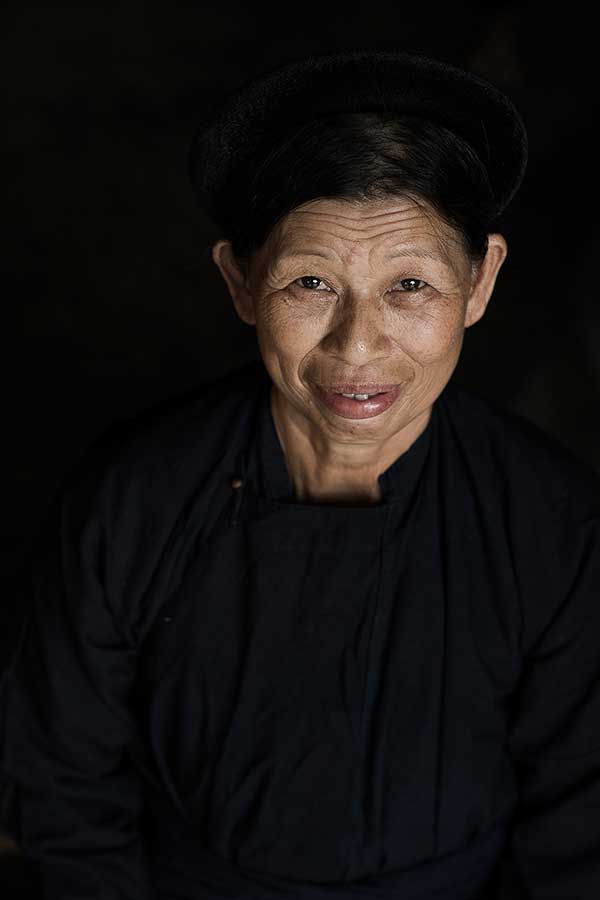
Tay
The Tay are Vietnam’s largest ethnic group and have a close relationship with the Kinh. They reside in the northern provinces; however, I met this particular Tay woman in the Central Highlands while I was leaving a Mnong Village. Unlike many mountain dwelling groups that live on steep slopes, the Tay settled in fertile valleys at the base of the mountain. In contrast with the very elaborate attire of many northern groups, the Tay costume is extremely subdued, composed of a straight skirt or trousers and a long tunique slit at the sides.
It is very similar to the ao dai, the Kinh traditional costume. Only the bright belt—traditionally made out of silk—shimmers in contrast to the cotton indigo-dyed dress.
Certain subgroups wear a shorter skirt and the Tay Pa Di adorn the austere costume with little touches of colour, silver elements and a cloth hat shaped like a house.
Population:
1,845,492 people (2019)
Location:
Cao Bang, Lang Son, Bac Kan, Quang Ninh, Bac Giang and Bac Ninh provinces
Other names:
Tho, Ngan, Phen, Thu Lao, and Pa Di
Language:
Tai–Kadai
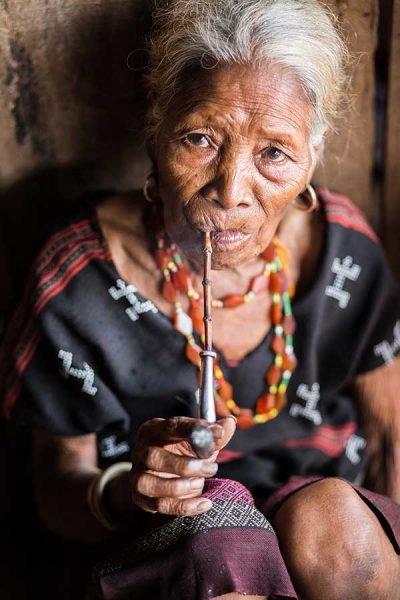
Ta Oi
Of the Ta Oi ethnic group’s three subgroups, only one, the Kan Tua people, still possesses the knowledge for how to make the traditional costume. Their weaving technique, called zeng, has the particularity of inlaying tiny glass beads into the brocaded pattern. Because this craftsmanship was slowly disappearing, a local woman decided to start workshops, not only to manufacture the costume again, but above all to teach the techniques. They now sell their products in cooperatives, which represents an opportunity for women to enhance their standard of living.
The woman pictured was very welcoming and invited me into her stilt house. I’ve returned often to visit this lady, who always sits in the same place, smoking her pipe. You can also see her pipe displayed in the museum.
Population:
52,356 people (2019)
Location:
Thua Thien-Hue Province and Quang Tri Provinces
Other names:
Toi Oi, Pa Co, Ba Hy, and Ba Ghy
Language:
Austroasiatic
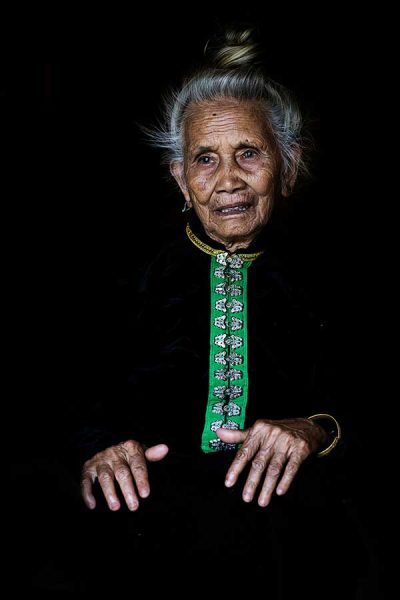
Thai
This ethnicity is divided into two groups – the White Thai and the Black Thai – and are said to have subgroups within each one. You can tell the differences between the two groups by their costume designs and architecture. They are also said to have different physical features, which help to distinguish them. Both groups live in lowlands, close to the river. The Thai were among the first ethnic groups known to live in the north of Vietnam and perhaps because of that they have greatly influenced other groups around them, such as the O Du, Kho Mu, Khang, Xinh Mun and La Ha.
They used to grow cotton and continue to take great pride in their textiles. The women in each family that I met still own their costumes; though I also learned that some O Du make traditional costumes for the Thai.
Population:
1,820,950 people (2019)
Location:
Lai Chau, Dien Bien, Son La, Hoa Binh, and Nghe An provinces
Other names:
Tay, Tay Dam, Tay Khao, Tay Muoi, Tay Thanh, Hang Tong, and Pu Thay
Language:
Tai–Kadai
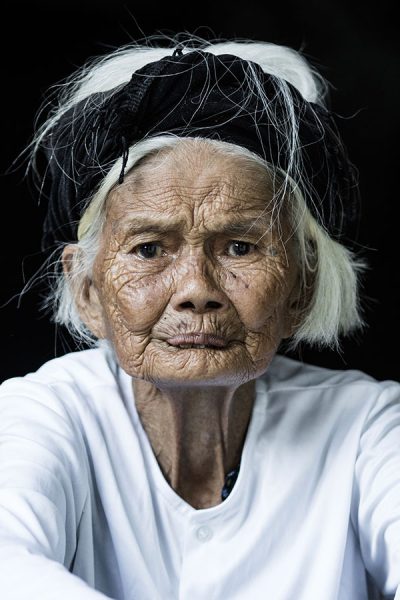
Tho
The Tho is one of the groups that has been the most difficult for me to connect with. I’ve approached them several times already; however, most of their tribes reside very close to the border of Laos, so it is complicated to visit with them due to security issues. Luckily, this time I was able to meet them in another part of the province and learn that there are many subgroups and some of them speak different dialects. In this region, their culture and traditional costumes have gradually been replaced by that of the Kinh.
Truong Thi Thinh, the woman in this portrait, is 101 years old and full of energy. The top of the costume that Madam Thinh is wearing was borrowed from a neighbor who still had the older version; the skirt is her own. One tradition that remains strong in this village is the musical culture of the gong, which was passed down from their ancestors. They have a new gong in the centre of the village, which is played regularly.
Population:
91,430 people (2019)
Location:
Nghe An Province
Other names:
Keo, Mon, Cuoi, Ho, Tay Poong, Dan Lai, and Ly Ha
Language:
Vietic
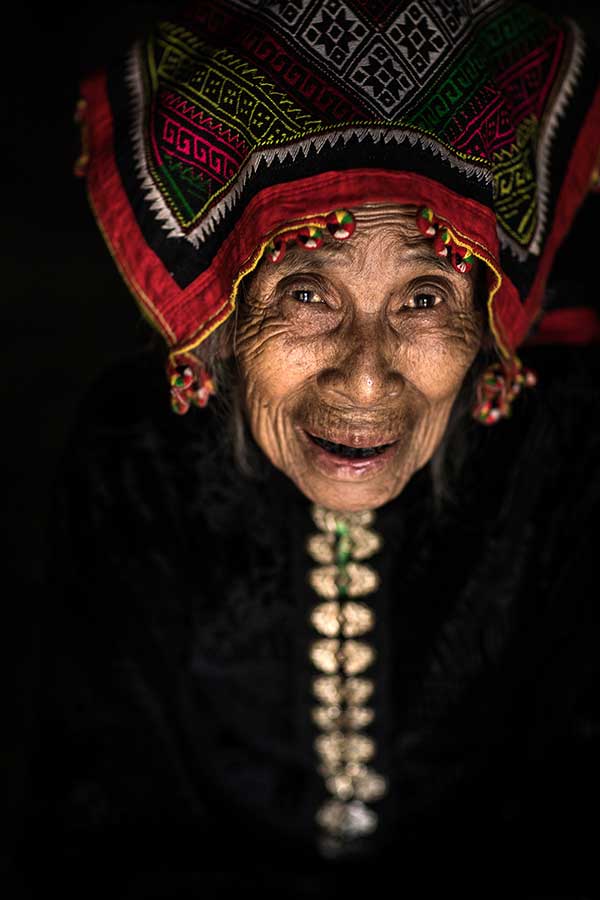
Xinh Mun
The Xinh Mun tribe is culturally similar to the Thai ethnic group, like many of the smaller groups in the Son La province. They are of Austro-Asian descent and still speak an indigenous language, which is unique to their tribe. Their village may be one of the last villages of its kind on the border of Laos. Since this village is in the frontier region of Vietnam, it is restricted, so I was not able to stay long. In this very remote area of Vietnam, the majority of the townspeople had never seen a foreigner before and were surprised when I showed up.
Vi Thi Inh was born in 1916 and at 103 years old, she was busy cooking for herself and her grandson when I arrived. When she saw me she said “Vao trong nha (come in)” right away and seemed to take meeting a foreigner in stride.
Population:
29,503 people (2019)
Location:
Son La and Lai Chau provinces and along the Vietnamese-Lao border regions.
Other names:
Puoc, and Pua
Language:
Austroasiatic
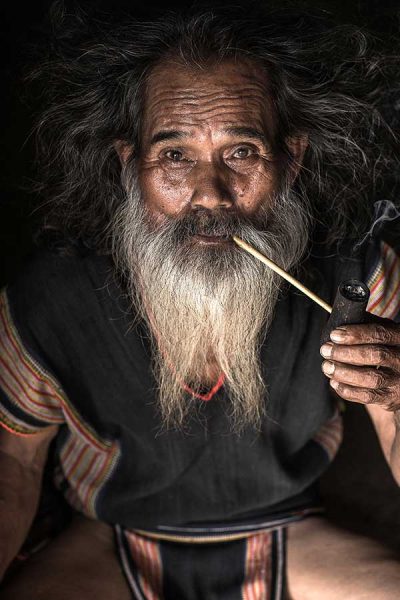
Xo Dang
In 2017, I met A Dip, 76, in the mountains around 50 kilometers from Kon Tum. He belongs to the To Dra ethnic group which is, according to the experts, a subgroup of the Xo Dang, even though their traditions and dialect are different, as stated by the To Dra. It was the first time that I’d come across this traditional costume. In many old missionary textbooks about the ethnic minorities in Vietnam, it is written that the Xo Dang did not make their own costumes and never had a textile tradition.
However, while speaking to some Xo Dang elders, I was told that at least one village used to make cotton fabrics and that they still have some of the cotton. In addition, traditions can vary from village to village even within the same ethnic group.
Population:
212,277 people (2019)
Location:
Mainly in Kon Tum Province and some in Quang Ngai and Quang Nam provinces.
Other names:
Xe Dang, Ca Dong, To Dra, Ha Lang, Mo Nam, Ta Tri, Ka Rang, Bri La Teng, and Con Lan
Language:
Austroasiatic
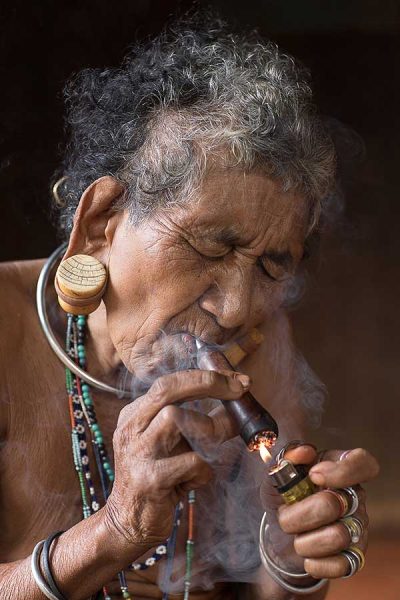
Xtieng
When I visited the Xtieng village near Ho Chi Minh, I spent a whole day exploring. Interestingly, I learned that the Xtieng count their ages according to the number of harvests they have gathered. The people were very warm and friendly but I was surprised by how hard it was to find a full original costume. The older women, who love smoking pipes, only wear skirts with no top and adorn themselves with beautiful beaded jewelry and rings on almost every finger. They also wear ivory in their earlobes, much like the Mnong and Brau ethnic groups.
The younger women tend to wear modern clothes and I couldn’t see any children wearing traditional costumes, so I don’t know for sure if they exist.
Population:
100,752 people (2019)
Location:
Binh Phuoc, Dong Nai and Tay Ninh provinces
Other names:
Xa Dieng and Stieng
Language:
Austroasiatic
To know more about the population of Vietnam, visit the official website of the government.

